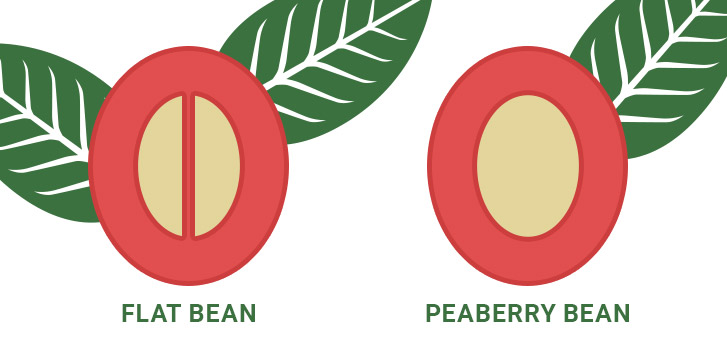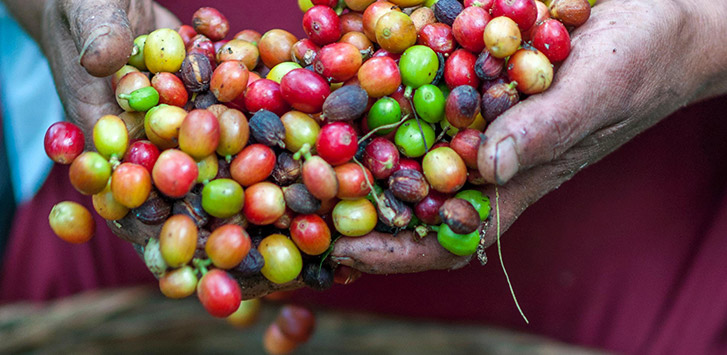
Surrounded in mystery, peaberry coffee is one of the most highly debated coffees. A naturally occurring phenomenon, peaberry coffee is a fun challenge for any roaster to tackle. With new, distinctive flavors and a bizarre shape, it’s essentially a rite of passage for roasters to try their hands at roasting peaberry coffee.
But what makes peaberry coffee so different from its non-peaberry counterparts? More importantly, why should you care? Hold on to your hats, and let’s find out!
What Is Peaberry Coffee?
Called “caracol” for snail in Spanish, peaberry coffee is a natural mutation that occurs inside the coffee cherry. Rather uncommon, this mutation makes up only 5-10% of the world’s coffee beans.
The rarity of these beans makes them more expensive. If they're actually worth the higher price point is a highly debated topic.
So, what sets peaberry beans apart from other coffee beans? Instead of developing with two halves, they develop into one whole bean. Because of this, they’re generally smaller, denser, and a rounder shape than average coffee beans.
How and why this mutation happens is still a mystery. All we have, currently, are theories. A couple of popular ones involve specific environmental conditions or insufficient pollination. But, so far, no one's been able to replicate the mutation.
It’s important to note that peaberry describes the actual coffee bean itself, not where it’s grown. This mutation can occur anywhere in the world.

Harvesting Peaberry Coffee Beans
Sorting peaberry coffee beans takes a lot of extra work. From the outside, you can't tell if a coffee cherry is hiding a regular coffee bean or a peaberry.
Once the coffee cherries are harvested and dried, coffee farmers hand sort them. The additional labor required to sort out peaberry coffee beans, along with their scarcity, doubles the price of the beans. But the real question is, are they worth the extra money?
Roasting Peaberry Coffee
To get the most out of your peaberry of choice, you need to keep in mind two key points:
- Don’t let the peaberry’s smaller size fool you — they’re denser than their “flat-sided” counterparts. That means you’ll need to increase your initial heat setting slightly to roast the coffee thoroughly and in a timely manner. This coffee doesn’t favor dark roasts and bakes easily.
- The geometry of peaberry coffee, generally, allows a more even roast. However, in fluid bed roasters (air roaster) like the Fresh Roast, bean movement is harder to get going because of the more aerodynamic design. You may have to start with slightly less coffee than normal if you use a fluid bed roaster.
All in all, don’t baby a peaberry! Throw it in, fire it up, and get it out after the first crack. You can almost always expect good results and a nice, even roast.
Is Peaberry Coffee Worth The Hype?
People go back and forth about this question, and there’s no easy yes or no. By itself, a peaberry coffee bean isn’t superior to your average coffee bean. Like normal, the growing conditions, altitude, processing method, and variety (i.e. Arabica or Robusta) play a huge role in the flavor and quality of the bean. However, some say that peaberry beans taste sweeter and richer than other coffee beans.
Because peaberry coffee beans are rounder and denser, it can also be harder to get a consistent roast. So it’s a lot harder to dial your roast in. But once you do, many say it’s worth the extra effort.
Peaberry Flavor Profile
Many believe, because there’s only one coffee bean produced, it gets all the nutrients that would’ve been split between the two coffee beans. They claim this gives the bean a little more caffeine, richer flavors, and a sweeter taste. The jury’s still out on this, so you’ll have to let us know what you think.
Mainly, peaberry coffee beans grab their flavor from their growing region. The altitudes, soil quality, and processing methods affect them just as much as any other varietal.
One type of peaberry coffee you must try is the Tanzania Peaberry. It’s a rare African coffee varietal that has a distinct aroma, fruity flavor, medium acidity, and clean finish. Best as a light roast, the Tanzanian peaberry coffee has notes of lemon, peach, and black tea.
Each origin offers an unique expression of the peaberry bean, adding to its allure and desirability.
If you’re really down to experiment, you should try the Kenyan peaberry vs. the Kenyan AA. You’ll be surprised at the difference that the peaberry mutation makes.
Conclusion
Is the peaberry worth it? You’ll have to try it yourself to answer that question. But it’s definitely a fun challenge to tackle when roasting, while bringing something new and interesting to the table.